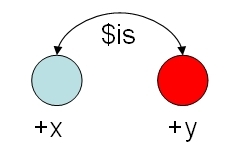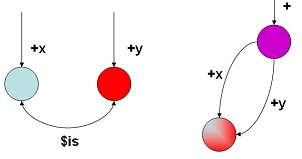xdi message
[Date Prev]
| [Thread Prev]
| [Thread Next]
| [Date Next]
--
[Date Index]
| [Thread Index]
| [List Home]
Subject: More comments on XDI metagraph predicate examples (was: RE: [xdi] Minutes: XDI TC Telecon Thursday 1-2PM PT 2008-12-18)
- From: Giovanni Bartolomeo <giovanni.bartolomeo@uniroma2.it>
- To: "Drummond Reed" <drummond.reed@cordance.net>
- Date: Fri, 09 Jan 2009 11:47:19 +0100
Hello Drummond,
thank you for your answers; but I fear I've some more concerns.. please
see my comments below.
Thanks,
Giovanni
At 09.09 30/12/2008, Drummond Reed
wrote:
Giovanni pointed out that Statement 6 in the xdi-rdf-graphing-v1 document
is
not consistent with the link contract example found on page 33 of
the
xdi-rdf-model-v11 document:
http://www.oasis-open.org/committees/download.php/29748/xdi-rdf-model-v11.pd
f
In that document, =drummond/$has/+friend$contract results in the XRI
=drummond+friend$contract, but it should be
=drummond(+friend$contract).
Drummond agreed this should be changed in the next version.
UPDATE: In his study of the Statement 6 issue identified by Markus,
Drummond
subsequently revised the proposed graph structure for compound $has
statements. This eliminates the issue identified by Markus and also
removes
the inconsistency with the V11 XDI RDF Model document. V2 of the XDI
RDF
Graphing document has been posted at:
[giovanni] To further clarify, I also
propose to have
(1) =drummond+friend/$has/$contract
instead of
(2) =drummond/$has/+friend$contract
even if they both result in
(3) =drummond+friend$contract
statement (2) seems to me to assert that a subject +friend$contract
exists regardless the context it is intended to be into (=drummond).
Statement (1) instead put $contract in the context of =drummond+friend
and +friend in the context of =drummond. Or maybe I'm missing
something?
[=Drummond] No, I think you are correct, statement (2) implies that there
is a XDI subject with the XRI +friend$contract. But I think that is
implied in all cumulative $has statements. As I clarified in the page I
just posted
(
http://wiki.oasis-open.org/xdi/XdiOne/RdfGraphModel), in an XDI
context, the XRI
=drummond+friend$contract infers all
of the following XDI RDF statements:
(a)
=drummond/$has/+friend/
(b)
=drummond+friend/$has/$contract
(c)
=drummond/$has/+friend$contract
[giovanni] Yes, I see that
+a/$has/+b+c ==> +a+b+c
+a+b/$has/+c ==> +a+b+c
however, if you want to REVERSE these statements, starting from
+a+b+c, you can infer EITHER (1) +a/$has/+b+c OR (2) +a+b/$has/+c OR (3)
both. And the outcomes are different in the three different cases.
In particular, if you have (1) +a/$has/+b+c, this implies that you
should have also +b/$has/+c.
But if you have (2), then you should have also +a/$has/+b.
Coming back to the example, from =drummond+friend$contract you may
infer
(1)
=drummond/$has/+friend/
=drummond+friend/$has/$contract
OR
(2)
+friend/$has/$contract
=drummond/$has/+friend$contract
OR (3)
both.
I think that (1) and (2) are asserting very different things and that (1)
is what we want to say, whereas (2) is not the same.
[giovanni] In example #8 (equivalence
+x/$is/+y) the arc connecting the two circles is labelled with +y, does
it have a particular meaning? Maybe, for consistency's sake, it is better
to maintain the graphical convention to name the arc after the predicate.
Since $is is a symmetric predicate, what do you think about the following
amendment?

[=Drummond] The graph you draw is 100% accurate – it is a depiction of
the full metagraph statement, i.e., of the XDI RDF statement +x/$is/+y.
The graph I was drawing is a depiction of the resulting statement in the
XDI RDF graph, which is that the node +x has a self-referential arc of
type +y. So both are correct, and I agree we should show both in the two
columns. I’ll make a note to revise that in the next
version.
[giovanni] Ok, I see. But in the graph in example #9
+x/$has$a/+y
+x/+y
the arc +y is used to represent a property belonging to +x (this also
applies to all meta-graphs depicted in the document). Thus wouldn't the
picture in example #8 read as: +x has a property +y whose value is +x
itself: +x/+y/+x ?
BTW I think this is strongly related to another issue which has come to
my mind. I remember that in the ATI model it was stated that addresses
refer to ARCs, not to NODEs. This is consistent with some OO programming
languages like c++ and Java which have the concepts of pointers and
objects. Pointers are represented through arcs pointing to nodes which
are objects. Maybe we have a similar issues here: XDI addresses might be
arcs, not nodes.

This should address also Markus' question:
[markus] BTW in your terminology, a predicate is not a node in the graph,
right? So predicates themselves don't have addresses?
What about to amend this
"Every *node* in the XDI RDF graph can be addressed by at least one
XRI
representing an XDI address, and every XDI address identifies a unique
*node*
in the XDI RDF graph."
into
"Every *ARC* in the XDI RDF graph can be addressed by at least one
XRI
representing an XDI address, and every XDI address identifies a unique
*ARC*
in the XDI RDF graph."
(..but maybe I can miss some issues here...)?
[Date Prev]
| [Thread Prev]
| [Thread Next]
| [Date Next]
--
[Date Index]
| [Thread Index]
| [List Home]

